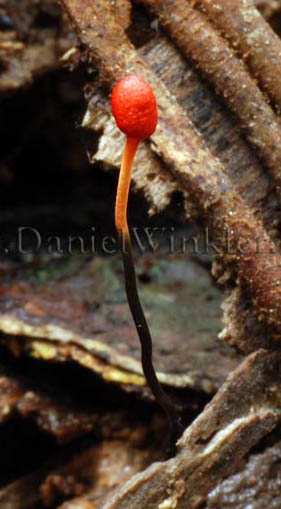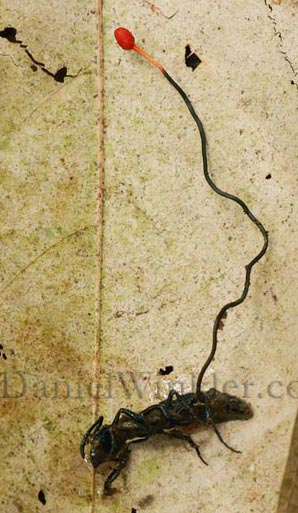Link to the 2014 Mushroaming Cordyceps Expedition to Tibet
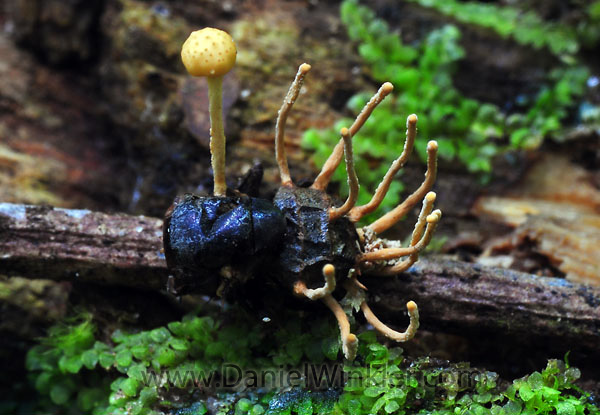
[More background on this species on the Corvallis Cordyceps page. Also there is a range of biomedical research published on this species, it contains exobiopolymers, which are important agents in industrial as well as health application, i.e. for wound healing.]
Cordyceps acridophila
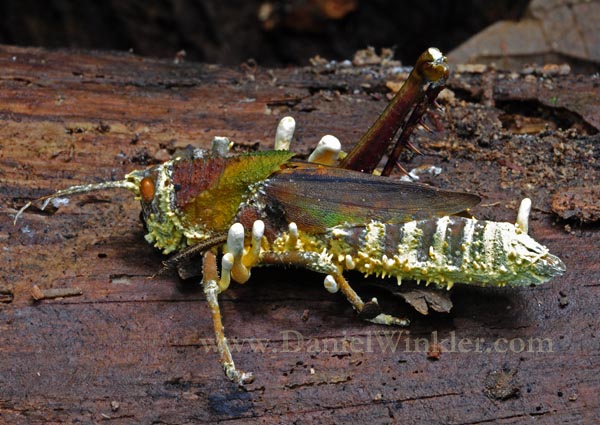
Akanthomyces sp.
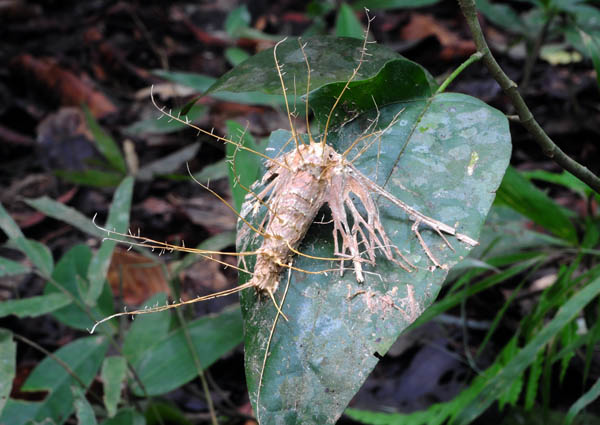
3) On of my favorite specimens was this oldish 8 cm sphinxoid moth digested by a Cordyceps. It is an Akanthomyces species (Tatiana suggests A. pistilariformis), an anamorphic fungus related to Cordyceps. Anamorphic means this fungus does not reproduce sexually with spores, but produces conidia, which have the same DNA as the fungus. It already has shed all its conidia, which grow on the antenna-like structures, called conidiophores. Check out Isaria tenuipes below, that gives you an idea how many conidia can be grown by an anamorph. The fungus affixed the moth to the leaf so it can keep this great perch to disperse its "spores" successfully. Madidi National Park, Bolivia.
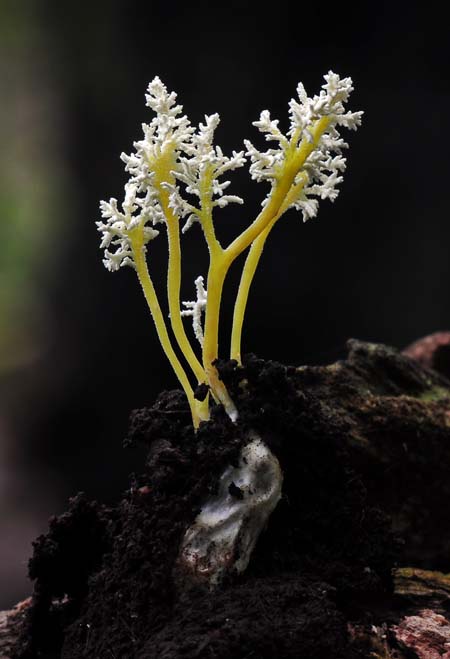
4) An Isaria tenuipes Peck, another Cordyceps-anamorph growing out of a Pupa of Noctunidae found in the hollow of a very decayed tree trunk.
Fruiting body height 5cm. Chalalan, Madidi National Park, Bolivia.

5) Another Isaria tenuipes with tons of conidia or conidiospores. The attic greek root of the term conidia means dust. Isaria is a cosmopolitan species. I am not sure if the infected insect was very hairy or some other organism is responsible for all the brittles. Chalalan, Madidi National Park, Bolivia.

6) A red fruiting Ophiocordyceps australis fruiting from an ant between Xylaria fruiting bodies. At first I was just trying to get a picture of the Xylaria then I saw theCordyceps. Key for finding Cordyceps is slowing down and looking carefully. Best substrate are decaying tree trunks, but many other locations are sites Cordyceps will direct its prey to before killing it and digesting it. Chalalan, Madidi National Park, Bolivia.

7) A transect of the head of an Ophiocordyceps australis reveals seed-like structures, which are the perithecia containing the asci-sacs in which the spores are produced. Size of the head is about 8 mm. Chalalan, Madidi National Park, Bolivia.
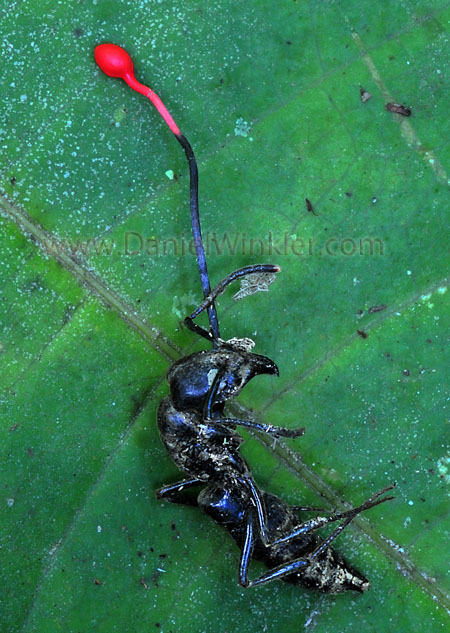
8) Ophiocordyceps australis growing out of an ant.
Cerro Brujo, Rurrenabaque, Bolivia
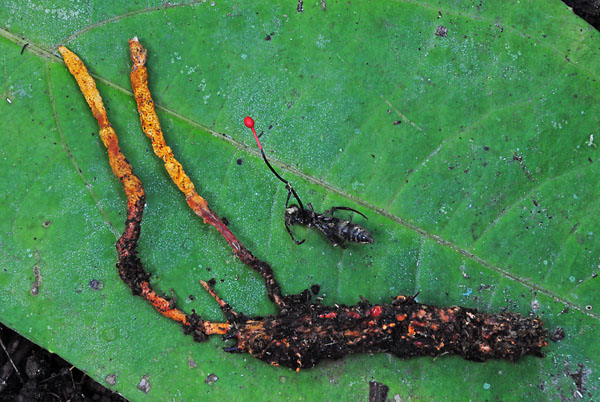
9) A late stage Metacordyceps, probably Metacordyceps martialis laying next to Ophiocordyceps australis.
Found by Brendan O'Brian at Cerro Brujo, Rurrenabaque, Bolivia
Metacordyceps sp.?
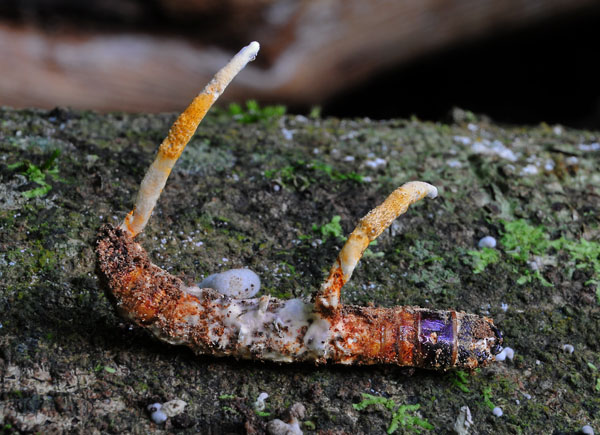
10) A much fresher specimen, probably a Metacordyceps. The fruiting bodies are growing out of a coleopteran larva (length ca 6 cm).
Cerro Brujo, Rurrenabaque, Bolivia
The enlarged fruiting body

10a) The yellow area in the center of the stromata contains mature perithecia. The darkish spots are the ostioles, the opening of the perithecium through which the spores are released. The top white part is not fully differentiated yet and still growing. When maturing it will turn yellow too and develop the pimpled surface due to growth of the perithecia.
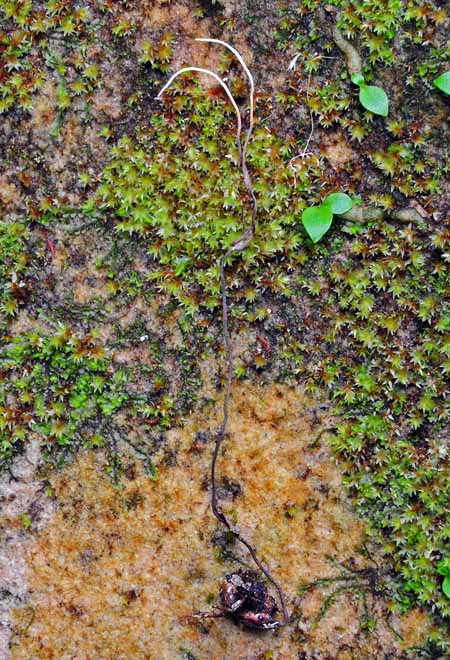
11) Probably a Hirsutella, a Cordyceps anamorph. As typical for an anamorph this specimen is lacking a well-defined "head". Hirsutella-species will depend on the digested insect. Found by Colden McClurg at Cerro Brujo, Rurrenabaque, Bolivia. Identified by Tatiana Sanjuan.

12) Ophiocordyceps kniphofioides var. ponerinae jutting out of a dead trunk. Ponerinae refers to the group of ants this Ophiocordyceps attacks. I love the orange-black contrast. The orange is the fertile tissue. Identified by Tatiana Sanjuan. Chalalan, Madidi National Park, Bolivia.

12a) Here the same Ophiocordyceps kniphofioides var. ponerinae with its victim or host, whichever perspective one takes, a Ponerinae ant dug out of the rotten wood. Unfortunately my camera was fogged-up that morning. Photographing in the rain forest, even when it does not rain is a real challenge. My flash stopped working for 5 days, but once out of the humidity it came back to life, go figure! Chalalan, Madidi National Park, Bolivia.
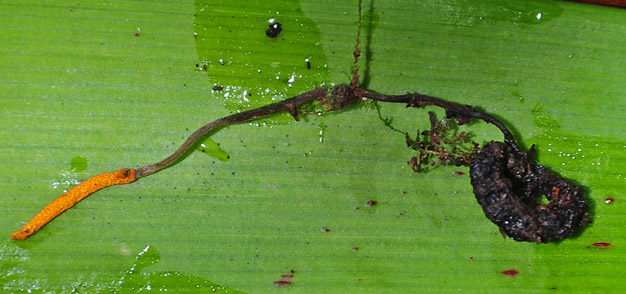
13) A similar looking Cordyceps we encountered in Coroico in the Yungas, the cloud forest belt in around 1500 m asl. Found by Nicole Cook.
If the host is a Megaloptera larvae, which it seems to be, then this would be the newly described Ophiocordyceps tiputini, according to Tatiana Sanjuan.
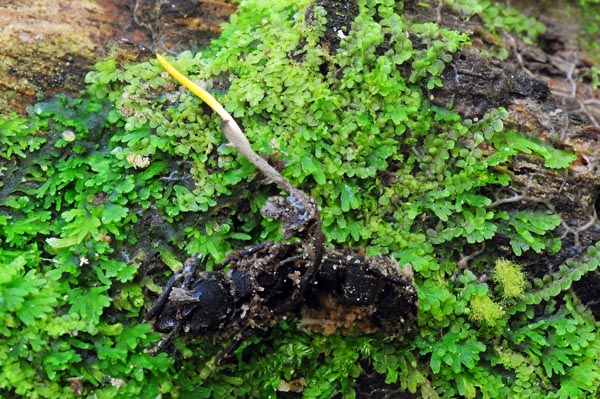
14) Another ant-parasitizing Ophiocordyceps kniphofioides var. ponerinae. This stroma is not fully matured yet.
Found by Brendan O'Brien at Cerro Brujo, Rurrenabaque, Bolivia.
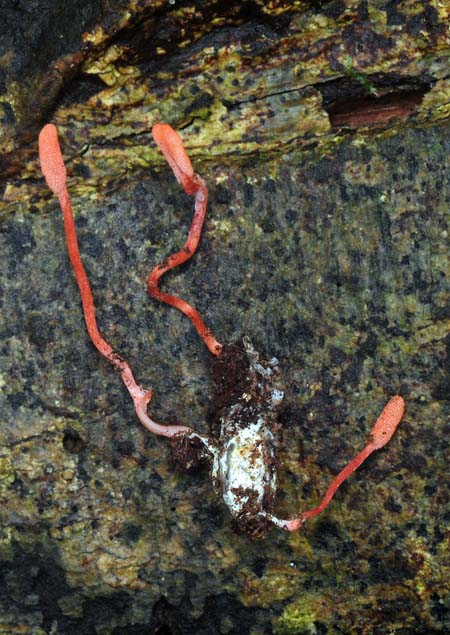
15) A brightly red fruiting Cordyceps growing out of some insect protein. Trying to figure out what it could be, I came up with Cordyceps pruinosa due to color and perithecia shape and alignment. However, so far this species is not described from the neotropics, but known from East Asia. Tatiana Sanjuan informed me that she found many specimen of C. pruinosa in the Amazon and depending on the host it could be C. caloceroides (parasitizing on Theraphosidae / tarantula) or C. pruinosa (parasitizing eggs of Acrididae / grasshoppers). Furthermore she sugests that with application of KOH these fungi turn purple. Found by Pat Hill in Chalalan, Madidi National Park, Bolivia.
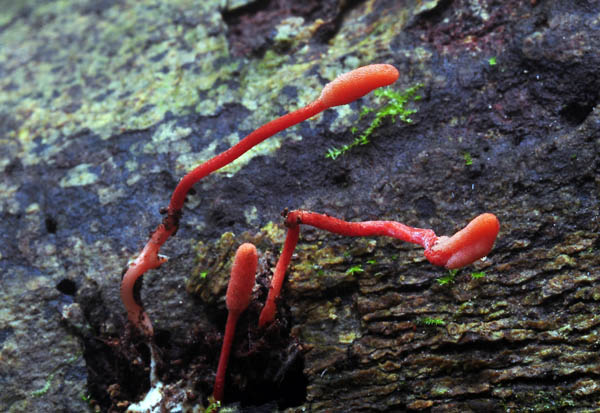
15a) Partly extracted from the log, the kink in one of the stromata was caused when it hit the tough bark and changed direction to find its way out.
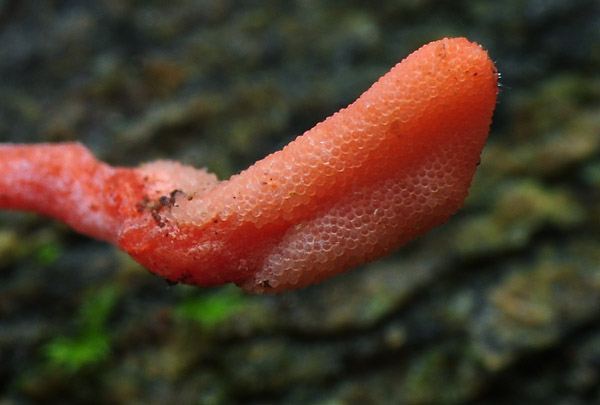
15b) What color, what beautiful structure! Chalalan, Madidi National Park, Bolivia.
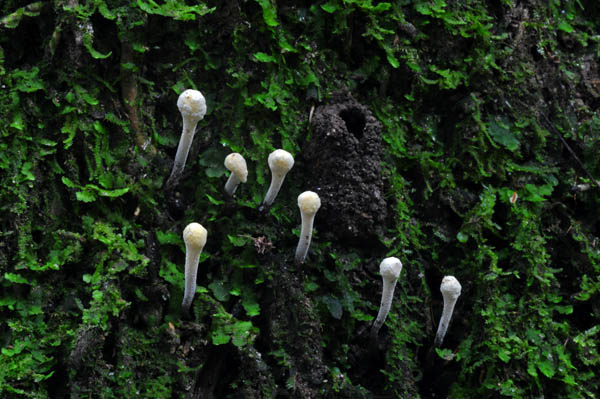
16) Fruiting bodies growing out of a mesh of palm roots. I waited for three days to unearth the host insect in hope the fungus would further mature. Unfortunately digging down to the host insect was impossible. It was all totally intertwined palm roots looking absolutely identical to the black lower part of the stromata and before I got to any insect I had already broken off or sliced off the fungal tissue from its elusive base. Last straw was when I cut my finger. Should have brought a big saw! Chalalan, Madidi National Park, Bolivia.
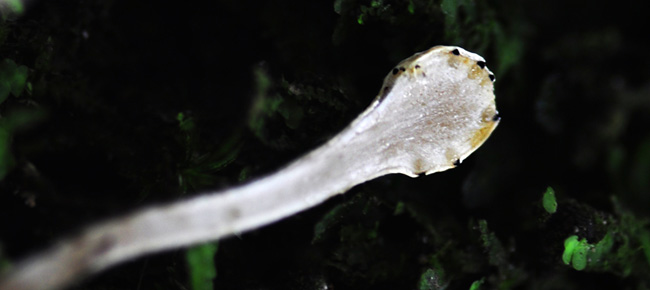
16a) Transect of the "Cordyceps" shown above. The perithecia are not fully developed yet. Larry Evans tried to find spores under the microscope, but to no avail.
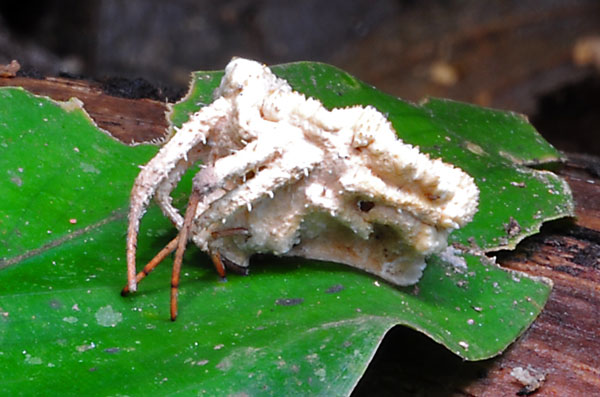
17) A Salticidae spider fully enmeshed in fungal tissue by a Torrubiella species. Size is about 3 cm across. Found by Colden McClurg near Caquihuara Macaw Cliff, Madidi National Park, Bolivia.
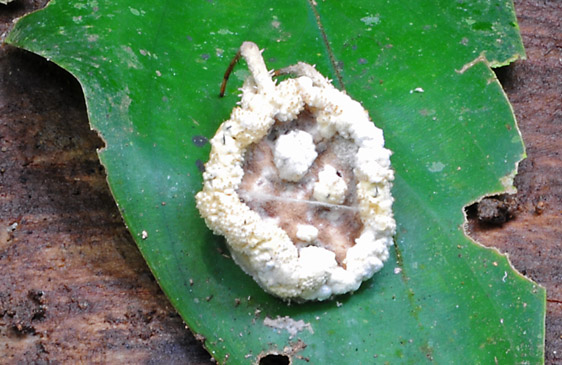
17a) Looking at the top of the former spider. The ring-like structure and the round knobs inside the ring are packed with perithecia<radeditorformatted_1> of the Torrubiella fungus.
Link to Mushroaming Cordyceps Expedition to East Tibet
Below an Ophiocordyceps on a weevil with a whole bunch of fruiting bodies growing out of it that is quite similar to Ophiocordyceps curculionum. However DNA analysis by Joey Spatafora, OSU Corvallis have shown that this is most likely a new species closely related to O. curulionum.
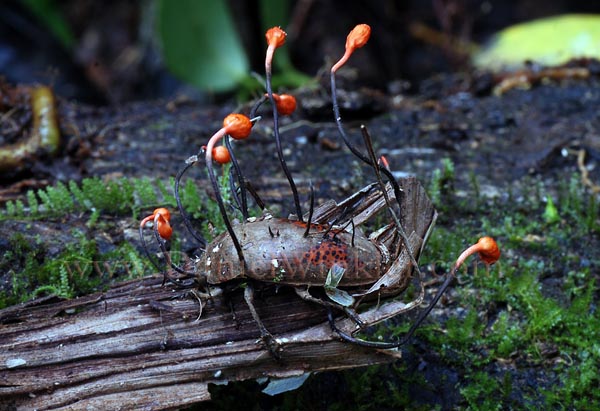
Close ups of the perithecia of Ophiocordyceps australis. What a great red these diminutive stromata display. The perithecia look close to maturity.
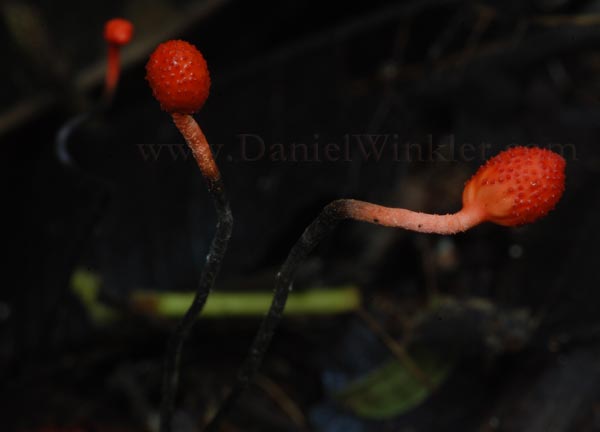
Below the fungus looks like a proper Ophiocordyceps australis, the most common pathogen in the neotropics. It infected a Conga ant (Paraponera sp.), which is one of the biggest ants in the Amazon. Fungus and ant measure about 12 to 15 cm (5 to 6 in). George Yager spotted the single stroma, I first thought it was a tiny red Mycena.
|
|
|
This ant was tiny, it measured only 1.2 cm (0.5 in) and you can imagine how small the fruiting body is. I only found it when I was taking multiple pictures of another O. australis and saw a tiny red spot down below.
I am not sure if this is a specimen of Ophiocordyceps australis itself, the red fertile tissue of the fruiting body is less rounded than the typical O. australis.
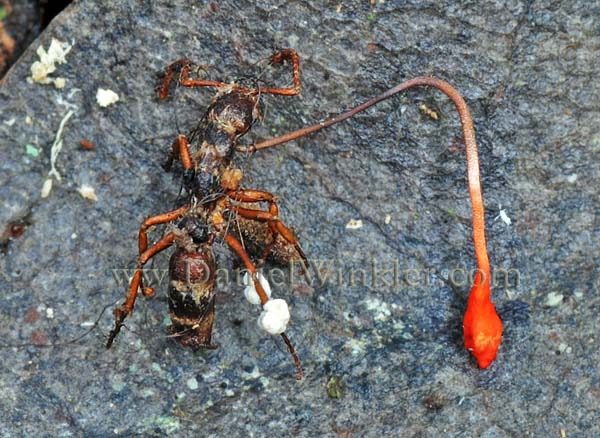
Note the white growths on the hind leg. They look like conidiomata, which produce spore-like conidia. Conidia are asexual spores, basically reproductive cell clones. Often Cordyceps are only reproducing through conidia. A fungal organism that only produces conidia is known as an anamorph. Anamorphs do not grow stromata or fruiting bodies, only teleomorphs do. Usually lack of fruiting bodies makes identification of a Cordyceps much more difficult.
Near the Umbuni waterfalls I found this creature. At first there were just a few brightly orange stromata visible coming out of a decaying trunk, a favorite site for Cordyceps to direct its prey to dig in before kill off.
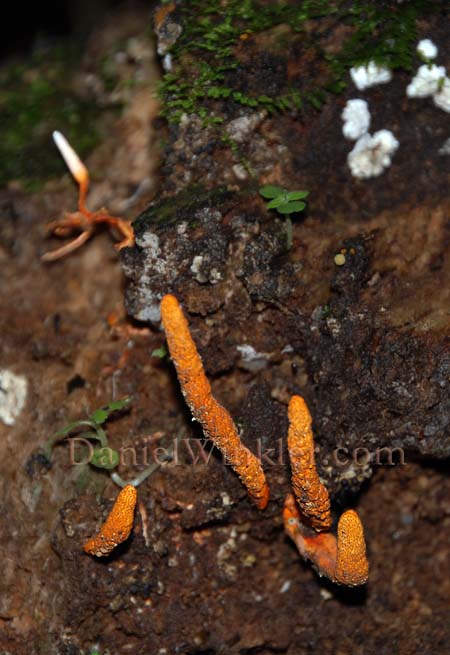
Once the fungus cum coleopteran [=beetle] larva was excavated this wild gestalt became visible:
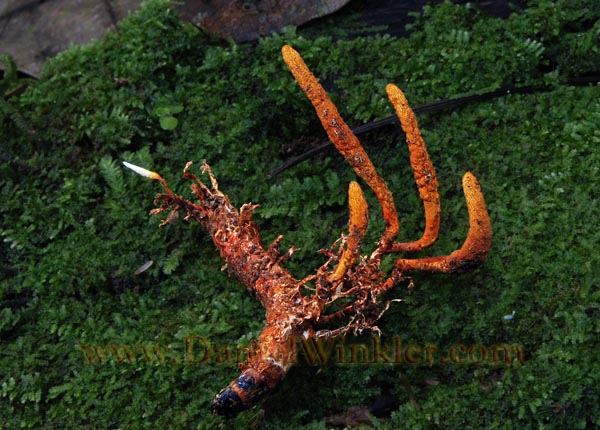
According to Prof. Spatafora this fungus is a member of Metacordyceps. However, these species seem to acquire hyperparasites quite easily, making the collection of molecular data difficult. A possible name for this morphology is Metacordyceps martialis. Update: It is now Nigelia martiale
If you want to track a turbulent taxonomy off this Metacordyceps here are the referneces:
First description as Cordyceps martialis Speg., Boletín de la Academia Nacional de Ciencias en Córdoba 11 (4): 535 (1889)
then it was quiet for 113 years and the wild ride started:
≡Metacordyceps martialis (Speg.) Kepler, G.H. Sung & Spatafora, Mycologia 104 (1): 185 (2012)
≡Metarhizium martiale (Speg.) Kepler, S.A. Rehner & Humber, Mycologia 106 (4): 823 (2014)
≡Nigelia martiale (Speg.) Luangsa-ard & Thanakitp., Mycological Progress 16 (4): 380 (2017)
Another Nigelia, probably N. martiale as well. White fertile stroma tissue is not common in Cordyceps and Ophicordyceps, but several Nigelia sport it. It is growing on a lepidopteran larva that was also buried in a decaying trunk. Check out the white perithecia.
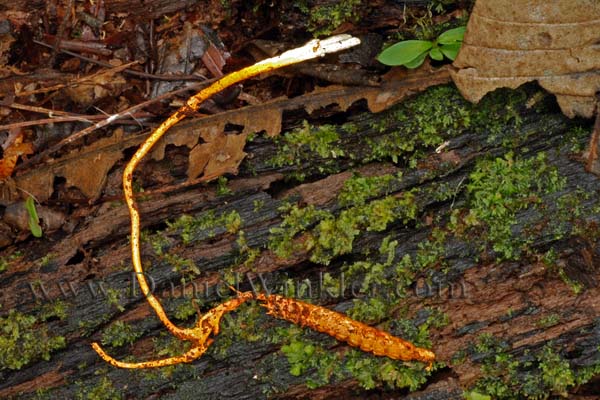
Close up of the stroma
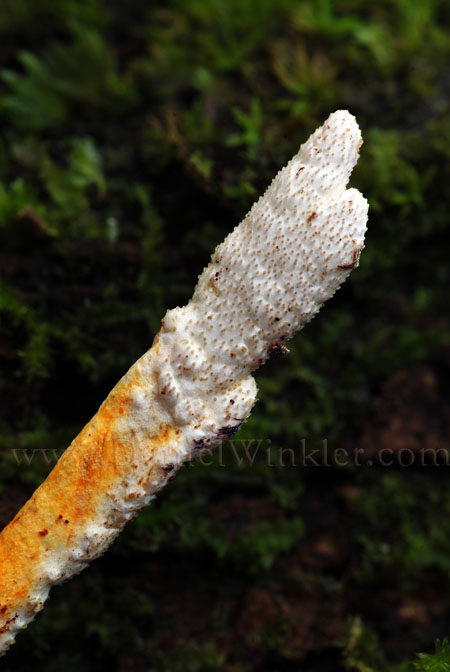
Cordyceps from Mindo, western slope of the Andes
Below a Cordyceps anamorph that could be Isaria tenuipes, a.k.a. Paecilomyces tenuipes, but there are also other morphologically similar anamorphs. We found it in on trunk near Mindo.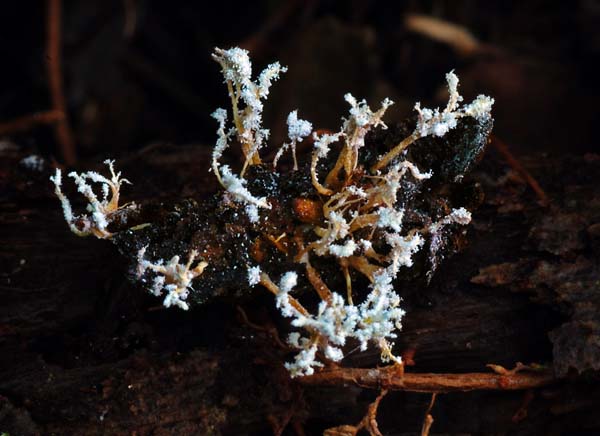
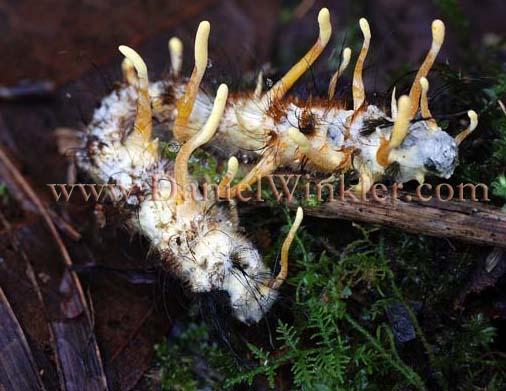
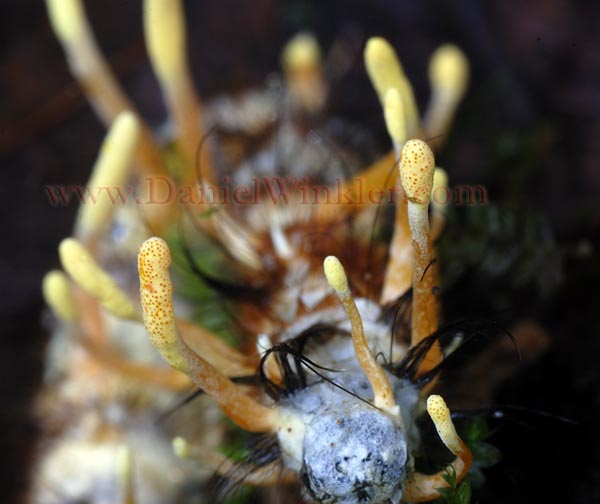
And finally an unidentified Cordyceps relative we found on the wall in our hobbit-style guest house in Mindo. Just wouldn't find a Cordyceps on your wall if it was an upper class hotel, right?
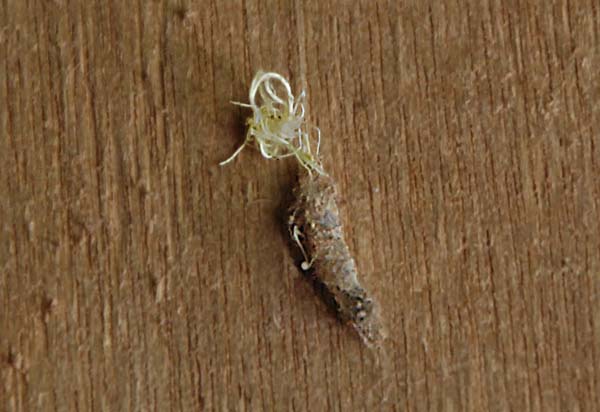
|
Bryce Kendrick's incredible find in Ecuador  What an incredible shot!
Bryce Kendrick encountered this spider in Ecuador killed by a fungus, probably Cordyceps caloceroides. According to Bryce, the spider is Tarantula (Theraphosidae) within the infraorder Mygalomorphae.
Photo: Bryce Kendrick Check out Bryce's incredible webpages
In 2020 I hit the check pot in Southern Colombia photographing a perfect specimen of Cordyceps caloceroides
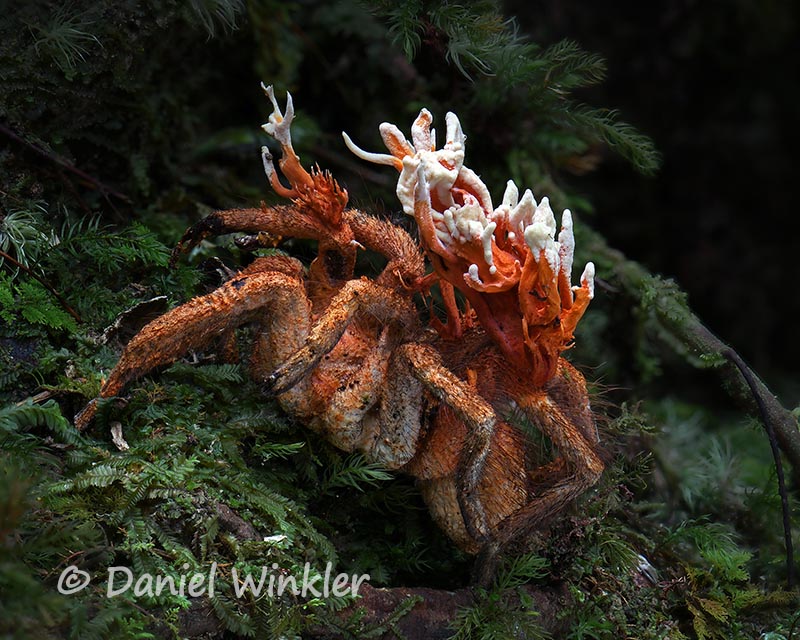 |
Excellent BBC movie showing a tropicalCordyceps taking over an ant.
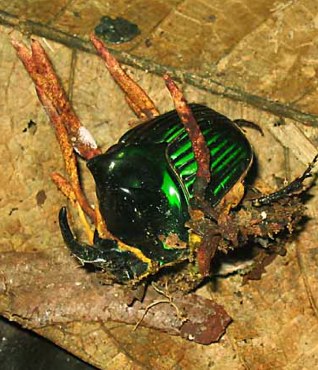 A Scarabaeus digested by a Cordyceps species, maybe from the Metacordyceps / Cordyceps martialis group. As Larry says, "Cordyceps is one of the most disturbing and useful sorts of medicinal mushrooms ever discovered, growing here on a scarab beetle. The Upper Amazon basin is a world biodiversity hotspot of these insect-eating fungi."
Jan. 2007, Madidi, Bolivia © Larry Evans
Link to Larry's Fungal Jungal
|
|

